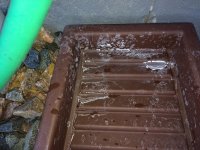daniboi81
New Member
Something that’s been nagging me regarding the softened is the white residue the softened water leaves behind after it dries. It also affects my skin in that I have to constantly apply lotion any time after I wash my hands, otherwise my skin dries out quickly. Below are the specifics of the water softener and raw well water.
Water Softener: 3M Water Softener 100 (Model# MWTS100; 32000 grain capacity, though I only get about 21K-22K grains removed at the salt dosage below)
Raw water hardness: ~60 gpg
TDS: ~875ppm (raw well water, un-softened); TDS of softened water is ~1060ppm
I have the softener set to regen every 9 days using 9.5 lbs of softener salt pellets (9.5 lbs is the manufacturer setting) with up flow brining (The 9 day calculation is based on our average water usage). I’ve played around with this setting adjusting it anywhere from 6.5lbs to 12 lbs, but cannot get rid of the white residue. I’ve attached a pic from our splash block to illustrate how pronounced this white residue is. It looks to me as if the residue is the softener salt itself. I have a separate spigot that dispenses the raw well water and notice the white residue is not nearly as pronounced.
Most of the research I've done so far suggests the white residue suggests that it may be due to high TDS; however I notice that it’s not nearly as pronounced with our neighbor’s water (abt 1/8th mile up the road from me). I tested the TDS of their softened water and it’s maybe 50ppm less than ours. The only difference with their system setup is they have a twin tank softener with what appears to be a whole house filter cartridge (not a whole house RO system).
I’d like to understand what may be the cause of this residue. Is it purely related to TDS in which case I'll have to live with it? Or could it be something related to the softener? With the differences noted with our neighbor’s setup above, would a twin tank system and a whole house filter cartridge make that much of a difference?
Water Softener: 3M Water Softener 100 (Model# MWTS100; 32000 grain capacity, though I only get about 21K-22K grains removed at the salt dosage below)
Raw water hardness: ~60 gpg
TDS: ~875ppm (raw well water, un-softened); TDS of softened water is ~1060ppm
I have the softener set to regen every 9 days using 9.5 lbs of softener salt pellets (9.5 lbs is the manufacturer setting) with up flow brining (The 9 day calculation is based on our average water usage). I’ve played around with this setting adjusting it anywhere from 6.5lbs to 12 lbs, but cannot get rid of the white residue. I’ve attached a pic from our splash block to illustrate how pronounced this white residue is. It looks to me as if the residue is the softener salt itself. I have a separate spigot that dispenses the raw well water and notice the white residue is not nearly as pronounced.
Most of the research I've done so far suggests the white residue suggests that it may be due to high TDS; however I notice that it’s not nearly as pronounced with our neighbor’s water (abt 1/8th mile up the road from me). I tested the TDS of their softened water and it’s maybe 50ppm less than ours. The only difference with their system setup is they have a twin tank softener with what appears to be a whole house filter cartridge (not a whole house RO system).
I’d like to understand what may be the cause of this residue. Is it purely related to TDS in which case I'll have to live with it? Or could it be something related to the softener? With the differences noted with our neighbor’s setup above, would a twin tank system and a whole house filter cartridge make that much of a difference?

